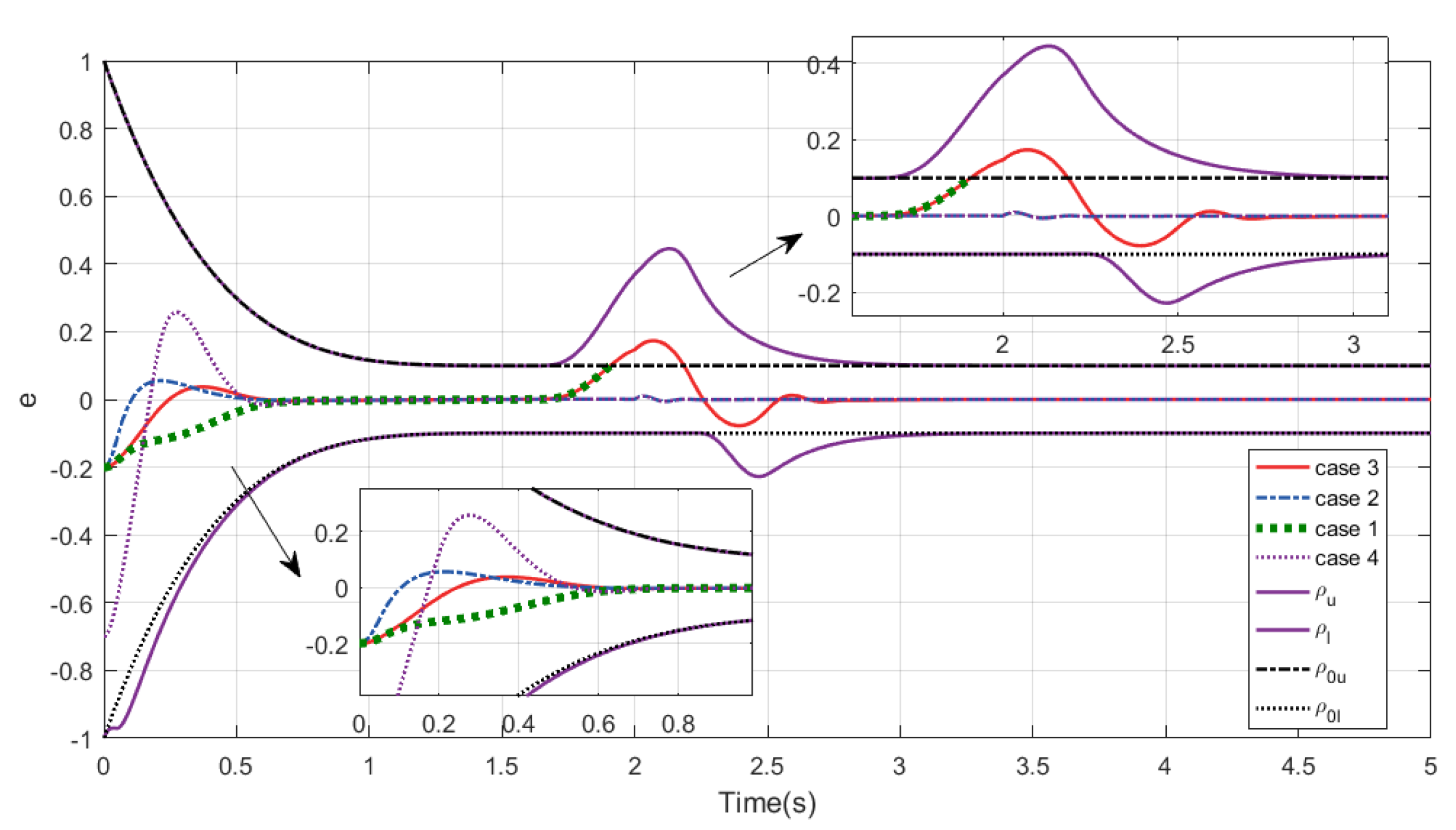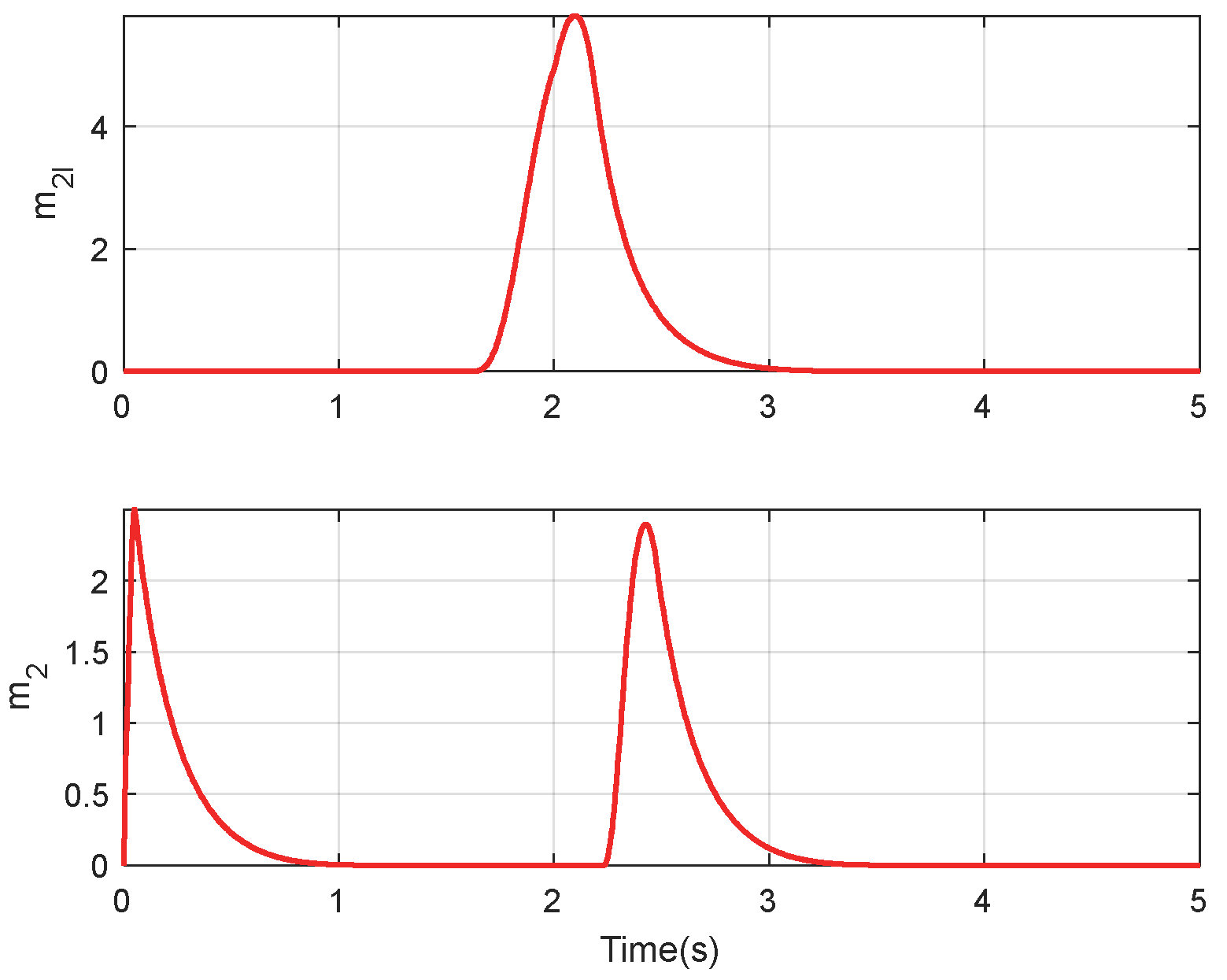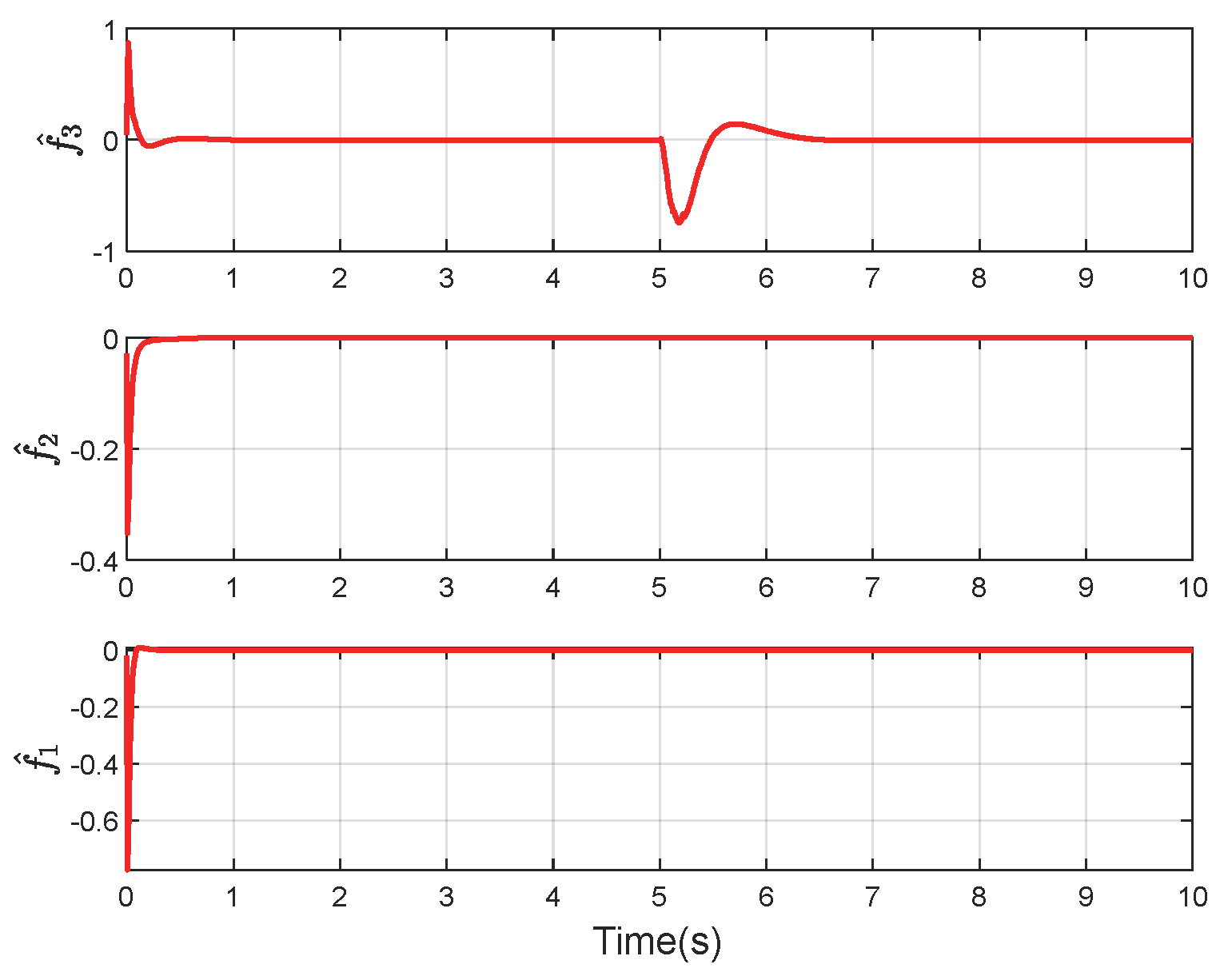A Robust Predefined Performance Controller for Reusable Launch Vehicles Under Mismatched Disturbance and Input Saturation
Abstract
1. Introduction
- (1)
- A novel ASPC is used to adjust the value of the PPF under actuator saturation. Compared with the existing PPC, the modified PPF can reduce the predefined performance to maintain the attitude tracking error within its range when actuator saturation occurs. Moreover, after the saturation process ends, the compensator decreases within a predefined time interval.
- (2)
- A novel fixed-time DO is constructed to estimate both matched and mismatched disturbances during the RLV re-entry process. The proposed fixed-time DO is concisely formed, and its estimation errors can converge to zero within a fixed-time interval.
- (3)
- A novel fixed-time DSC method, based on the fixed-time DO, is developed to enhance the robust performance of the RLV control system. A nonlinear first-order filter is adopted to avoid the “explosion of complexity” problem and ensure the fixed-time stability of the control system.
2. Problem Formulation and Preliminaries
2.1. Problem Formulation
2.2. Preliminary
- (1)
- is positive and decreasing.
- (2)
- and , where is a predefined time parameter.
- (3)
- has continuous first- and second-order derivatives with respect to time.
3. Control System Design
3.1. Prescribed Performance Function with Anti-Saturation Compensator and Error Transformation
3.2. Anti-Saturation Predefined-Time Compensator Design
3.3. Fixed-Time Disturbance Observer
3.4. Controller Design and Stability Analysis of the Whole System
4. Simulation and Analysis
4.1. Simulation of Double Integrator System
4.2. Simulation of an RLV Model
5. Conclusions
- (1)
- A PPF that is based on an ASPC is derived to ensure stability when saturation occurs. The ASPC can vanish within the predefined time interval after the saturation process ends, which reduces the impact on the PPF. In addition, it can reduce predefined performance when actuator saturation occurs, preventing ambiguity issues.
- (2)
- A fixed-time DO is introduced to estimate the mismatched and matched disturbances within a fixed-time interval. Its convergence time is independent of the initial error state, which helps in the pre-tuning of the control parameters.
- (3)
- On the basis of error transformation, a fixed-time DSC is proposed, and the converted system states converge to the residual set of the origin within a fixed time.
Author Contributions
Funding
Data Availability Statement
Acknowledgments
Conflicts of Interest
References
- Chai, R.; Tsourdos, A.; Savvaris, A.; Chai, S.; Xia, Y.; Chen, C.P. Review of advanced guidance and control algorithms for space/aerospace vehicles. Prog. Aerosp. Sci. 2021, 122, 100696. [Google Scholar] [CrossRef]
- Tian, B.; Li, Z.; Zhang, X.; Zong, Q. Adaptive prescribed performance attitude control for RLV with mismatched disturbance. Aerosp. Sci. Technol. 2021, 117, 106918. [Google Scholar] [CrossRef]
- Kerr, M.; Marcos, A.; Pein, L.; Bornschlegl, E. Gain Scheduled FDI for a Re-Entry Vehicle. In Proceedings of the AIAA Guidance, Navigation and Control Conference and Exhibit, Honolulu, HI, USA, 18–21 August 2008. [Google Scholar]
- Cai, G.; Duan, G.; Hu, C. A velocity-based LPV modeling and control framework for an air-breathing hypersonic vehicle. Int. J. Innov. Comput. Inf. Control IJICIC 2011, 75A, 8115–8135. [Google Scholar]
- Zhao, S.; Li, X.; Bu, X.W.; Zhang, D. Prescribed Performance Tracking Control for Hypersonic Flight Vehicles with Model Uncertainties. Hindawi Ltd. 2019, 2019, 3505614. [Google Scholar] [CrossRef]
- Wang, F.; Hua, C.; Zong, Q. Attitude control of reusable launch vehicle in reentry phase with input constraint via robust adaptive backstepping control. Int. J. Adapt. Control. Signal Process. 2015, 29, 1308–1327. [Google Scholar] [CrossRef]
- Bu, X.; He, G.; Wang, K. Tracking control of air-breathing hypersonic vehicles with non-affine dynamics via improved neural back-stepping design. ISA Trans 2018, 75, 88–100. [Google Scholar] [CrossRef] [PubMed]
- Shtessel, Y.; Hall, C.; Jackson, M. Reusable Launch Vehicle Control In Multiple Time Scale Sliding Modes. J. Guid. Control. Dyn. 1999, 23, 1013–1020. [Google Scholar] [CrossRef]
- Shtessel, Y.B.; Hall, C.E. Multiple time scale sliding mode control of reusable launch vehicles in ascent and descent modes. In Proceedings of the American Control Conference, Arlington, VA, USA, 25–27 June 2001; IEEE: New York, NY, USA. [Google Scholar]
- Han, Z.; Zong, Q.; Tian, B.L.; Ji, Y.H. Hypersonic vehicle attitude control using Terminal sliding mode control. Kongzhi Yu Juece/Control. Decis. 2013, 28, 259–263+268. [Google Scholar]
- Burken, J.J.; Lu, P.; Wu, Z.; Bahm, C. Two Reconfigurable Flight-Control Design Methods: Robust Servomechanism and Control Allocation. J. Guid. Control. Dyn. 2012, 24, 482–493. [Google Scholar] [CrossRef]
- Hanson, J.M. Advanced guidance and control project for reusable launch vehicles. In Proceedings of the AIAA Guidance, Navigation, and Control Conference and Exhibit, Dever, CO, USA, 14–17 August 2000. [Google Scholar]
- Bu, X.; Wu, X.; Ma, Z.; Zhang, R. Nonsingular direct neural control of air-breathing hypersonic vehicle via back-stepping. Neurocomputing 2015, 153, 164–173. [Google Scholar] [CrossRef]
- Wang, F.; Zou, Q.; Zong, Q.; Hua, C. Adaptive Prescribed Performance Fault Tolerant Control for a Flexible Air-Breathing Hypersonic Vehicle With Uncertainty. IEEE Access 2019, 7, 35018–35033. [Google Scholar] [CrossRef]
- Jing, Y.; Liu, Y.; Zhou, S. Prescribed Performance Finite-Time Tracking Control for Uncertain Nonlinear Systems. J. Syst. Sci. Complex. 2019, 32, 803–817. [Google Scholar] [CrossRef]
- Bu, X. Guaranteeing prescribed output tracking performance for air-breathing hypersonic vehicles via non-affine back-stepping control design. Nonlinear Dyn. 2017, 91, 525–538. [Google Scholar] [CrossRef]
- Su, R.; Zong, Q.; Tian, B.; You, M. Comprehensive design of disturbance observer and non-singular terminal sliding mode control for reusable launch vehicles. IET Control. Theory Appl. 2015, 9, 1821–1830. [Google Scholar] [CrossRef]
- Zhang, X.; Chen, K.; Fu, W.; Huang, H. Neural Network-Based Stochastic Adaptive Attitude Control for Generic Hypersonic Vehicles with Full State Constraints. Neurocomputing 2019, 351, 228–239. [Google Scholar] [CrossRef]
- Xu, B.; Shou, Y.; Luo, J.; Pu, H.; Shi, Z. Neural Learning Control of Strict-Feedback Systems Using Disturbance Observer. IEEE Trans. Neural Netw. Learn. Syst. 2018, 30, 1296–1307. [Google Scholar] [CrossRef]
- Wang, M.; Yang, Y.; Bai, Y. A novel predefined performance barrier function based adaptive sliding mode control method for RLV under mismatched disturbance. Aircr. Eng. Aerosp. Technol. 2024, 96, 501–513. [Google Scholar] [CrossRef]
- Wang, M.; Wei, C.; Pu, J.; Cui, N. Predefined-Time Nonsingular Attitude Control for Vertical-Takeoff Horizontal-Landing Reusable Launch Vehicle. Appl. Sci. 2022, 12, 10153. [Google Scholar] [CrossRef]
- Ma, H.; Zhou, Q.; Li, H.; Lu, R. Adaptive prescribed performance control of a flexible-joint robotic manipulator with dynamic uncertainties. IEEE Trans. Cybern. 2021, 52, 12905–12915. [Google Scholar]
- Wang, Z.; Liang, B.; Sun, Y.; Zhang, T. Adaptive fault-tolerant prescribed-time control for teleoperation systems with position error constraints. IEEE Trans. Ind. Inform. 2019, 16, 4889–4899. [Google Scholar] [CrossRef]
- Yuan, X.; Chen, B.; Lin, C. Neural adaptive fixed-time control for nonlinear systems with full-state constraints. IEEE Trans. Cybern. 2021, 53, 3048–3059. [Google Scholar] [CrossRef]
- Ju, X.; Wei, C.; Xu, H.; Wang, F. Fractional-order sliding mode control with a predefined-time observer for VTVL reusable launch vehicles under actuator faults and saturation constraints. ISA Trans. 2022, 129, 55–72. [Google Scholar] [CrossRef] [PubMed]
- Ye, D.; Zou, A.M.; Sun, Z. Predefined-time predefined-bounded attitude tracking control for rigid spacecraft. IEEE Trans. Aerosp. Electron. Syst. 2021, 58, 464–472. [Google Scholar] [CrossRef]
- Liu, K.; Wang, R.; Wang, X.; Wang, X. Anti-saturation adaptive finite-time neural network based fault-tolerant tracking control for a quadrotor UAV with external disturbances. Aerosp. Sci. Technol. 2021, 115, 106790. [Google Scholar] [CrossRef]
- Hu, C.; Gao, Z.; Ren, Y.; Liu, Y. A robust adaptive nonlinear fault-tolerant controller via norm estimation for reusable launch vehicles. Acta Astronaut. 2016, 128, 685–695. [Google Scholar] [CrossRef]
- Guo, Y.; Guo, J.; Song, S. Backsteping control for attitude tracking of the spacecraft under input saturation. Acta Astronaut. 2017, 138, 318–325. [Google Scholar] [CrossRef]
- Zhang, L.; Liu, J.; Cui, N. Backsteping control for a two-link manipulator with appointed-time convergence. ISA Trans. 2022, 128, 208–219. [Google Scholar] [CrossRef]
- Zhang, L.; Wei, C.; Wu, R.; Cui, N. Adaptive fault-tolerant control for a VTVL reusable launch vehicle. Acta Astronaut. 2019, 159, 362–370. [Google Scholar] [CrossRef]













| Parameters | |
|---|---|
| PPF | , , , |
| ASPC | , , , |
| Fixed-time DO | , , , , , |
| DSC | , , , , |
| Structural parameters of RLV | , , Reference length The cross-sectional area Mass , , , , , , |
| Initial state variables of RLV | , , , , , , |
Disclaimer/Publisher’s Note: The statements, opinions and data contained in all publications are solely those of the individual author(s) and contributor(s) and not of MDPI and/or the editor(s). MDPI and/or the editor(s) disclaim responsibility for any injury to people or property resulting from any ideas, methods, instructions or products referred to in the content. |
© 2025 by the authors. Licensee MDPI, Basel, Switzerland. This article is an open access article distributed under the terms and conditions of the Creative Commons Attribution (CC BY) license (https://creativecommons.org/licenses/by/4.0/).
Share and Cite
Guo, D.; Wang, M.; Cheng, J.; Zhang, Y.; Cui, N. A Robust Predefined Performance Controller for Reusable Launch Vehicles Under Mismatched Disturbance and Input Saturation. Appl. Sci. 2025, 15, 12251. https://doi.org/10.3390/app152212251
Guo D, Wang M, Cheng J, Zhang Y, Cui N. A Robust Predefined Performance Controller for Reusable Launch Vehicles Under Mismatched Disturbance and Input Saturation. Applied Sciences. 2025; 15(22):12251. https://doi.org/10.3390/app152212251
Chicago/Turabian StyleGuo, Dongzi, Mingze Wang, Jie Cheng, Yuhao Zhang, and Naigang Cui. 2025. "A Robust Predefined Performance Controller for Reusable Launch Vehicles Under Mismatched Disturbance and Input Saturation" Applied Sciences 15, no. 22: 12251. https://doi.org/10.3390/app152212251
APA StyleGuo, D., Wang, M., Cheng, J., Zhang, Y., & Cui, N. (2025). A Robust Predefined Performance Controller for Reusable Launch Vehicles Under Mismatched Disturbance and Input Saturation. Applied Sciences, 15(22), 12251. https://doi.org/10.3390/app152212251





